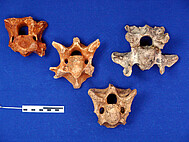Collections of the Palaeontology and �Evolution section
The palaeontological collections of the SMNK comprise about 450,000 specimens and specimen complexes, which are documented in catalogues and card files. The palaeontological collections are grouped as follows:
- Invertebrates (excluding insects) (sorted by time period and locality)
- Insects (sorted by time period and locality)
- Vertebrates (sorted by taxa and locality; the Synapsida are still unsorted)
- Quarternary (sorted by taxa and locality)
- Palaeobotany (sorted by time period and locality)
- Ichnotaxa and coproliths (sorted by time period and locality)
Areas of focus in the vertebrate collection, grouped by time period and locality:
- Quarternary mammals – Upper Rhine Graben
- Early Miocene – Höwenegg/Öhningen
- Middle Oligocene – Unterfeld clay pit
- Middle Eocene – Messel pit
- Muschelkalk – Kraichgau
- Permian – Kupferschiefer
Specialties:
- Late Permian tetrapods from the "Korbach Fissure"
- Fishes, especially bony fishes
- Mastodonsaurs of the Upper Buntsandstein - Cappel
- Pterosaurs
- Crocodilians
- Tertiary birds
- Original Frenzen collection (Jurassic microfossils)
- Middle Pleistocene mammals from Mauer (Geol.-Pal. Institute Heidelberg)
- Artifacts
- Cambrian Burgess Shale – Wilhelm Paulcke Collection







